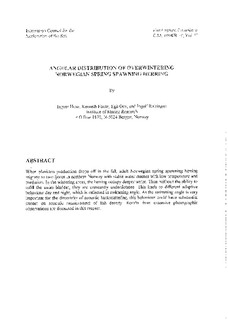| dc.contributor.author | Huse, Ingvar | |
| dc.contributor.author | Foote, Kenneth G. | |
| dc.contributor.author | Ona, Egil | |
| dc.contributor.author | Røttingen, Ingolf | |
| dc.date.accessioned | 2008-04-07T12:11:50Z | |
| dc.date.issued | 1994 | |
| dc.identifier.uri | http://hdl.handle.net/11250/100319 | |
| dc.description | Fish Capture Committee | en |
| dc.description.abstract | When plankton production drops off in the fall, adult Norwegian spring spawning herring migrate to two fiords in northern Norway with stable water masses with low temperature and predation. In the wintering areas, the herring occupy deeper water. Thus, without the ability to refill the swim bladder, they are constantly underflotated. This leads to different adaptive behaviour day and night, which is reflected in swimming angle. As the swimming angle is very important for the directivity of acoustic backscattering, this behaviour could have substantial impact on acoustic measurement of fish density. Results from extensive photographic observations are discussed in this respect. | en |
| dc.format.extent | 968382 bytes | |
| dc.format.mimetype | application/pdf | |
| dc.language.iso | nob | en |
| dc.publisher | ICES | en |
| dc.relation.ispartofseries | ICES CM documents | en |
| dc.relation.ispartofseries | 1994/B:19 | en |
| dc.title | Angular distribution of overwintering Norwegian spring spawning herring | en |
| dc.type | Working paper | en |
| dc.subject.nsi | VDP::Agriculture and fishery disciplines: 900::Fisheries science: 920::Resource biology: 921 | en |
| dc.source.pagenumber | 14 s. | |
